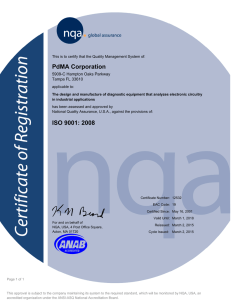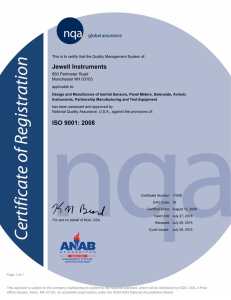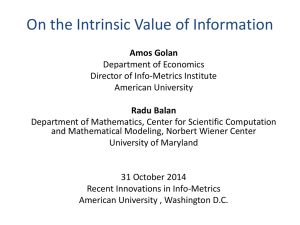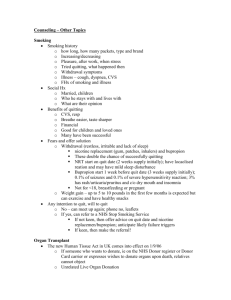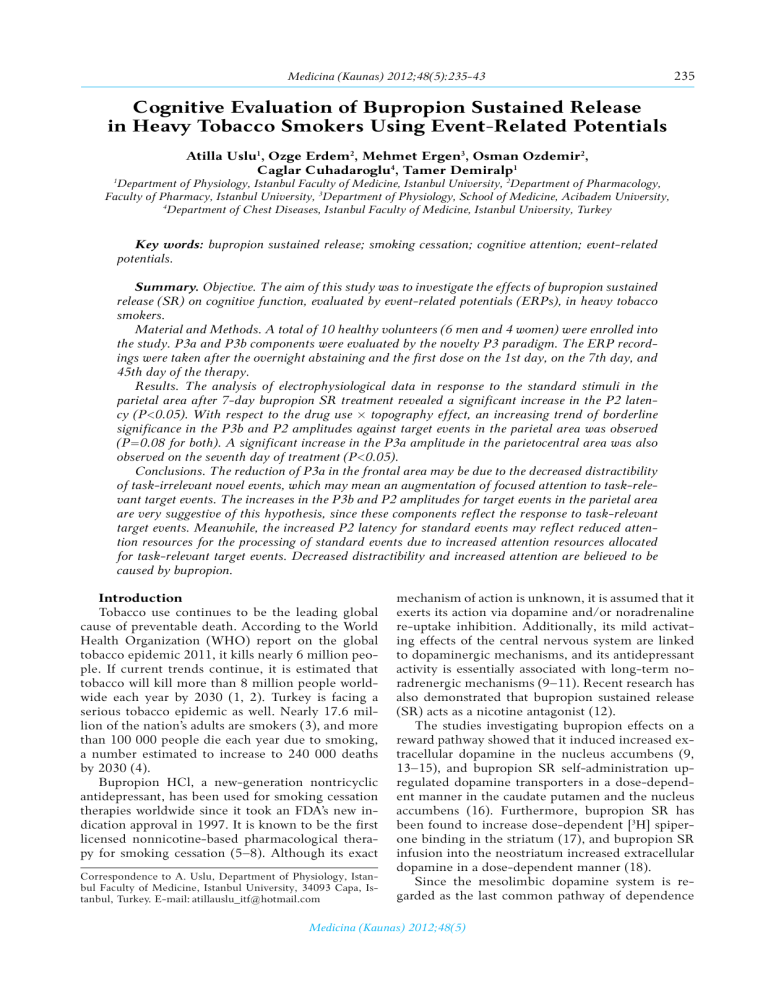
Medicina (Kaunas) 2012;48(5):235-43 235 Cognitive Evaluation of Bupropion Sustained Release in Heavy Tobacco Smokers Using Event-Related Potentials Atilla Uslu1, Ozge Erdem2, Mehmet Ergen3, Osman Ozdemir2, Caglar Cuhadaroglu4, Tamer Demiralp1 Department of Physiology, Istanbul Faculty of Medicine, Istanbul University, 2Department of Pharmacology, Faculty of Pharmacy, Istanbul University, 3Department of Physiology, School of Medicine, Acibadem University, 4 Department of Chest Diseases, Istanbul Faculty of Medicine, Istanbul University, Turkey 1 Key words: bupropion sustained release; smoking cessation; cognitive attention; event-related potentials. Summary. Objective. The aim of this study was to investigate the effects of bupropion sustained release (SR) on cognitive function, evaluated by event-related potentials (ERPs), in heavy tobacco smokers. Material and Methods. A total of 10 healthy volunteers (6 men and 4 women) were enrolled into the study. P3a and P3b components were evaluated by the novelty P3 paradigm. The ERP recordings were taken after the overnight abstaining and the first dose on the 1st day, on the 7th day, and 45th day of the therapy. Results. The analysis of electrophysiological data in response to the standard stimuli in the parietal area after 7-day bupropion SR treatment revealed a significant increase in the P2 latency (P<0.05). With respect to the drug use × topography effect, an increasing trend of borderline signi­fi­cance in the P3b and P2 amplitudes against target events in the parietal area was observed (P=0.08 for both). A significant increase in the P3a amplitude in the parietocentral area was also observed on the seventh day of treatment (P<0.05). Conclusions. The reduction of P3a in the frontal area may be due to the decreased distractibility of task-irrelevant novel events, which may mean an augmentation of focused attention to task-relevant target events. The increases in the P3b and P2 amplitudes for target events in the parietal area are very suggestive of this hypothesis, since these components reflect the response to task-relevant target events. Meanwhile, the increased P2 latency for standard events may reflect reduced attention resources for the processing of standard events due to increased attention resources allocated for task-relevant target events. Decreased distractibility and increased attention are believed to be caused by bupropion. Introduction Tobacco use continues to be the leading global cause of preventable death. According to the World Health Organization (WHO) report on the global tobacco epidemic 2011, it kills nearly 6 million people. If current trends continue, it is estimated that tobacco will kill more than 8 million people worldwide each year by 2030 (1, 2). Turkey is facing a serious tobacco epidemic as well. Nearly 17.6 million of the nation’s adults are smokers (3), and more than 100 000 people die each year due to smoking, a number estimated to increase to 240 000 deaths by 2030 (4). Bupropion HCl, a new-generation nontricyclic antidepressant, has been used for smoking cessation therapies worldwide since it took an FDA’s new indication approval in 1997. It is known to be the first licensed nonnicotine-based pharmacological therapy for smoking cessation (5–8). Although its exact Correspondence to A. Uslu, Department of Physiology, Istanbul Faculty of Medicine, Istanbul University, 34093 Capa, Istanbul, Turkey. E-mail: atillauslu_itf@hotmail.com mechanism of action is unknown, it is assumed that it exerts its action via dopamine and/or noradrenaline re-uptake inhibition. Additionally, its mild activating effects of the central nervous system are linked to dopaminergic mechanisms, and its antidepressant activity is essentially associated with long-term noradrenergic mechanisms (9–11). Recent research has also demonstrated that bupropion sustained release (SR) acts as a nicotine antagonist (12). The studies investigating bupropion effects on a reward pathway showed that it induced increased extracellular dopamine in the nucleus accumbens (9, 13–15), and bupropion SR self-administration upregulated dopamine transporters in a dose-dependent manner in the caudate putamen and the nucleus accumbens (16). Furthermore, bupropion SR has been found to increase dose-dependent [3H] spiperone binding in the striatum (17), and bupropion SR infusion into the neostriatum increased extracellular dopamine in a dose-dependent manner (18). Since the mesolimbic dopamine system is regarded as the last common pathway of dependence Medicina (Kaunas) 2012;48(5) 236 Atilla Uslu, Ozge Erdem, Mehmet Ergen, Osman Ozdemir, et al. and the neuroanatomical basis of the reinforcing effects, it is assumed that dopaminergic mechanisms play the main role in smoking cessation to decrease nicotine craving and dysphoria due to abstinence. On the other hand, it has been suggested that bupropion SR is a functional inhibitor of nicotinic acetylcholine receptors (nAChRs) in both the muscle and the ganglia (19), and it blocks α3β2, α4β2, and a7 neuronal nAChRs with some degree of selectivity (20). On the contrary, Young and Glennon (21) have shown that bupropion SR displayed a nicotinelike stimulation effect in a two-lever drug discrimination task, but did not act like an antagonist as mecamylamine did. For a better understanding of the action mechanisms of a psychopharmacological agent, the evaluation of its effects on patients by using the well-established neuropsychological tests and neurophysiological measurements is important. Eventrelated potentials (ERPs) as noninvasive electrophysiological measures of perceptual and cognitive processes are well-suited for such an evaluation. They consist of a series of peaks and troughs, which appear in the ongoing electroencephalogram (EEG) in response to occurrence of discrete events, such as presentation of a stimulus (22, 23). One of the most extensively studied endogenous ERP components is the P3 wave. It occurs in response to rare and task-relevant stimuli (target stimuli) among a series of frequent (standard) stimuli. It is a positive wave with a maximum amplitude in the parietal scalp area and has a typical peak latency of 300–600 ms that reflects the speeds of stimulus identification and categorization. On the other hand, the amplitude of P3 is inversely proportional to the rarity of presentation, i.e., probability. Thus, it is believed that P3 indicates on-line updating of working memory (24–27). It reflects a process of memory updating by which the current model of environment is modified as a function of incoming information. However, it can also be used as an index of attention function as it is modulated by attention. If the third “novel” event is added to the classical “oddball paradigm,” a positive component different from P3 is observed. Having an earlier latency than the target P3 (P3b) and a distribution more frontally, it is called P3a. It is thought to reflect the distractibility to novel events, such as a dog bark or a door creak, among standard and target tones. The P3a component reflects initial processing when a novel or distracting stimulus is detected, whereas P3b reflects the subsequent attention resources when a target stimulus engages memory operations during task performance (28–30). Neuropsychological tests also serve as useful tools to measure the cognitive effects from a behav- ioral perspective. A Continuous Performance Test (CPT), which can measure processing speed in addition to focused and sustained attention, might be useful in evaluating the effects of bupropion SR on the attention system. Furthermore, a wide variety of presentation methods (auditory, visual, or verbal) and performance measures, such as hit rate, commission (impulsivity), and omission (inattention), can be used in this test (31). Other test, the DigitSymbol Substitution Test (DSST), a derivative of the Wechsler Adult Intelligence Scale-Digit Symbol Test, can be used as a measure of psychomotor performance, motor persistence, sustained attention, response speed, visuomotor coordination, and perceptual organization (32). This study evaluated the ERP and behavioral data from heavy tobacco smokers being treated at the Smoking Cessation Outpatient Clinic (Department of Chest Diseases, Istanbul Faculty of Medicine, Istanbul University). The aim of this study was to investigate the effects of bupropion SR on cognitive functions as measured by ERPs in heavy tobacco smokers by evaluating the electrophysiological and behavioral evidences. We aimed to assess whether bupropion SR acted as a nicotine-like stimulant or not, and whether these effects served as a possible substitute for smoking during abstinence. For such an evaluation, P3a measures could enable us to evaluate the distractibility of the patient during abstinence, and by P3b, it would be possible to discuss if focused attention was impaired. Two arousal states can be mentioned according to the complementary roles for dopamine and noradrenaline in the mediation of arousal states (33, 34): upper and lower arousal mechanisms. The “upper” arousal mechanism (mediated by noradrenaline) modulates the activity of the “lower” arousal mechanism (mediated by dopamine). Therefore, dopamine or noradrenaline-based bupropion effects can be investigated using the cognitive evidence from P3a and P3b. Material and Methods This study was conducted in accordance with the Declaration of Helsinki. Participants were informed about the test paradigm and ERP recording procedures; all subjects gave written informed consent. Participants. Ten healthy volunteers (6 men and 4 women) participated in the study. The demographic characteristics and smoking history (mean age, years smoked, and cigarettes per day) of the participants are presented in Table 1. All participants underwent physical examination, had good physical, pulmonary, and mental health, did not use any medications known to affect the central nervous system, and were free of neurological or psychiatric disorders. The participants with a history of hepatic Medicina (Kaunas) 2012;48(5) Cognitive Evaluation of Bupropion SR in Heavy Tobacco Smokers Using ERPs Table 1. Demographic Characteristics and Smoking History of Patients (n=10) Variable Value Male-to-female ratio 6:4 Age, years 42.0 (11.8) [23–62] Education, years 13.1 (2.6) [8–15] Smoking history, years 20.6 (9.3) [5–30] No. of cigarettes per day 32.0 (9.2) [20–40] FTND, score* 7.6 (2.2) [6–12] Values are mean (standard deviation) [range] unless otherwise indicated. FTND, Fagerström Test for Nicotine Dependence. *A score of 6 and more indicates nicotine dependence. and renal failure were excluded from study as bupropion is known to be extensively metabolized in the liver to active metabolites and excreted by the kidneys. The Fagerström Test for Nicotine Dependence (FTND) was used for assessing nicotine dependence (32). This test is a 6-item measure that is scored between 0 and 10, with higher scores reflecting greater nicotine dependence (35). The patients were given the standard bupropion SR tablet (Zyban®, GlaxoSmithKline, Research Triangle Park, NC) therapy at a dosage of 150 mg/ day for the first 3 days and then 150 mg twice daily thereafter for a study period of 7 weeks. The target day for quitting smoking was 1 week after the beginning of the therapy. Although the major side effects of bupropion are nausea or vomiting, insomnia, dizziness and headaches, these side effects were not observed in the subjects of our study. The patients were invited for the first recording in the morning after overnight abstinence. The second recording was taken on the same day after the first dose of bupropion SR (150 mg) with an adequate time interval for the peak plasma concentration during recording (36, 37). By the first and second recordings, it was expected to see the acute effects of the drug during abstinence. Considering that the drug reached a steady state concentration on the seventh day of the treatment, the third recording was taken while the patient was still smoking. The fourth recording was taken on the 45th day, which was within the last week of the therapy. The first three recordings were taken from all of the patients, whereas the last week participation was low due to failure to quit smoking. Additionally, the CPT and the DSST were carried out before the recordings for a general neuropsychological evaluation. It took approximately 10 minutes to complete these tests, including the warm-up period. ERP Recording Conditions. EEGs were recorded in the Electroneurophysiology Laboratory, Department of Physiology. The participants were comfortably seated in an armchair in a dimly illuminated, sound-attenuated, and electrically shielded room. 237 Electrical activity of the brain was recorded using Ag/AgCl EEG ring electrodes at F3, Fz, F4, C3, Cz, C4, T3, T4, P3, Pz, P4, O1, Oz, O2 electrode locations according to the extended international 10/20 placement system with a forehead ground. To observe the eye movement artifacts, electro-oculogram (EOG) activity was recorded bipolarly from two-cup electrodes located at the outer canthus of the right eye and the nasion. Electromyography (EMG) electrodes were located in the metaphalangeal area to track the extension of the index finger. Electrode impedance was kept below 20 kΩ. EEG and EOG were amplified by a La Mont®, 32-channel EEG type 2 amplifier (Wisconsin 53719, USA) with a band pass filter of 0.1–70 Hz and digitized with a sampling rate of 256 Hz and stored on the hard disk of a PC for off-line analysis. Stimuli and Procedure. Stimulus presentation was carried out by a MATLAB® program. ERPs were recorded while the subjects performed auditory and visual tasks. Auditory Novelty Oddball Task. For a cognitive evaluation, the novelty P3 experiment with standard, target, and novel auditory stimuli was applied. The stimuli were 1000-Hz (standard), 2000-Hz (target) tones of 50-ms duration, and novel stimuli, such as a dog bark or door creak, which were presented at 80 dB with an interstimulus interval (ISI) of 2000 ms. The two different tones and the novel stimuli were presented in a random order, such that the probabilities of the standard, target, and novel stimuli were 60%, 20% and 20% of the 300 total trials, respectively. The patient was instructed to respond to target tones by the extension of the index finger of the right hand, which was measured using two EMG electrodes located on the metaphalangeal area. Visual Continuous Performance Test. The patients were given a visual CPT, in which a series of letters were presented on a computer screen as visual stimuli. A total of 400 letters were presented in each trial, each letter appearing 160 ms with an ISI of 800 ms. The patient was seated comfortably in front of the computer and instructed to respond to the “A”s, which appeared after the “Z”s, but not the other “A”s. The response to each stimulus and the reaction time was saved on the computer for analysis. To measure the performance, reaction time (for the hits) and hit rate, omission, and commission scores were evaluated. Neuropsychological Assessment. The DSST was administrated to 10 heavy tobacco smokers being treated at the Smoking Cessation Outpatient Clinic. The DSST used was a classical paper and pencil test, in which the patient was asked to match the digits (1–9) with a specific symbol. There were 2 tables in the test. The upper table contained 10 symbols, each Medicina (Kaunas) 2012;48(5) 238 Atilla Uslu, Ozge Erdem, Mehmet Ergen, Osman Ozdemir, et al. of which was paired with a digit between 1 and 9. The lower one contained 75 randomized digits with empty boxes below, which the patient was asked to complete with the matching symbol (32). The patients were told to complete the empty boxes from left to right as fast as they could, and the time to perform the test was measured using a chronometer. To avoid the learning effects, 6 parallel forms were used. Data Analysis. MATLAB® R2008a (MA 017602098, USA) software package was used for EEG data analysis. EEG was epoched between 500-ms prestimulus and 1000-ms poststimulus time window. Single trials with EEG or EOG amplitudes exceeding ±90 µV were rejected automatically as an artifact. After this procedure, EEG epochs were manually examined, and trials with other visible artifacts (e.g., muscle artifacts) were rejected. P3 amplitude was measured relatively to the mean of the 100 ms prestimulus baseline, and the peak latency was assessed as the time from stimulus onset to maximum peak amplitude within the latency window of 250– 400 ms. The N1-P2 complex was identified as the most negative and positive points between 80 ms and 250 ms. Statistical Analysis. SPSS® 16.0 package (Chicago, IL 60606-6412, USA) was used for statistical analysis. First, repeated-measures ANOVA test with the within-subjects factors of anteroposterior (AP) distribution (frontal vs. central vs. parietal), drug condition (predrug vs. first dose vs. seventh day) and drug use × AP interaction were applied for the statistical analyses of the ERP results. The Greenhouse-Geisser correction was applied to the degrees of freedom when the repeated measure factor contained more than 2 levels, with only the corrected probability values reported. In a second stage, P3a, P3b, and P2 amplitudes were reanalyzed after the data were normalized by vector length to assess whether the drug use × AP interaction was topographically robust and to evaluate lateralization effects by including the left and right locations. For this purpose, the amplitude value of each subject was divided by the square root of the sum of the squared amplitudes over the 3-midline electrode locations (Fz, Cz, and Pz) for each stimulus under each condition. ANOVA tests for repeated measures with the within-subjects factors of AP distribution (frontal vs. central vs. parietal), lateralization (LAT) (left vs. midline vs. right), and drug condition (predrug vs. first dose vs. seventh day) were applied to the normalized data. To evaluate the behavioral data, again repeated measures ANOVA tests with the within-subjects factors of drug use (predrug vs. first dose vs. seventh day) were applied. Each of the CPT scores (hit rate, omission, and commission) and DSST scores were evaluated individually. Results There were only 5 patients who succeeded in quitting smoking and participated in the study until the 45th day of the therapy, whereas the first 3 recordings were available for all 10 patients. Therefore, it was focused on the first 3 recordings, which were documented before the treatment, after the first dose, and on the seventh day. Electrophysiological Data Fig. 1 illustrates the grand averages ERP waveforms of the patients’ responses to the standard, novel, and target stimuli on midline. The primary effects with the drug use caused an increase in the P3a and P3b amplitudes in responses to the novel and target stimuli, especially in the parietal region, and the longer P2 latency in responses to the standard stimuli. Tables 2, 3, and 4 display the results of statistical analysis applied to the electrophysiological data. N1-P2. The analysis of the ERP data in response to the standard stimuli during the treatment indicated that there was a significant increase in the P2 latency after the 7-day treatment with bupropion SR (F2,18=4.37; P<0.05). Fig. 2 illustrates the mean P2 latencies from the first 3 recordings. Although the P2 latency in ERPs to the standard stimuli was slightly shorter after the first dose, it was significantly longer after 7 days. With respect to drug use × AP interaction, there was an increase of borderline significance in the P2 amplitude in response to the target events in the parietal area (F4,36=2.89; P=0.08). However, this interaction effect disappeared after the vector transformation. No other significant differences in the N1 and P2 components were seen; the analysis of the data with respect to the topography showed that N1 and P2 were, as expected, largest in the fronto-central and parietocentral areas, respectively. P3a. There was a significant increase in the P3a amplitude in the parieto-central area on the seventh day of drug administration (drug use × AP, F4,36=4.01; P<0.05). With respect to the AP distribution, P3a showed a typical central distribution before the drug treatment. Displaying a central distribution after the first dose, P3a was observed to shift more parietal as the treatment continued. The vector transformation procedure increased the significance of this drug use × AP interaction effect (P<0.01). The P3a latency was slightly shorter due to the treatment, but the difference was not statistically significant. The top row in Fig. 3 presents the topographic distribution of P3a before the treatment, after the first dose, and on the seventh day of treatment, which emphasizes the shift in the P3a topography to the parietal location on the seventh day. This effect is further visualized in Fig. 4 using the line graphs of midline amplitudes. Medicina (Kaunas) 2012;48(5) 240 Atilla Uslu, Ozge Erdem, Mehmet Ergen, Osman Ozdemir, et al. P3b amplitude increased the significance of this drug use × AP interaction effect (P=0.07). The bottom row in Fig. 2 presents the topographic distribution of P3b wave before the treatment, after administration of the first dose, and on the seventh day of treatment. It also emphasizes an increase in the P3b amplitude after administration of the first dose and on the seventh day of treatment, indicating that the increase of P3b amplitude after the first dose is localized in the parietal area. This effect is further visualized in Fig. 5 using the line graphs of midline amplitudes. 220 215 P2 Latency, ms 210 205 200 195 190 185 180 175 Predrug First Dose 7th Day Fig. 2. P2 latency in responses to the standard events as a function of drug use P3b. Drug treatment did not have any significant effect on P3b amplitudes and latencies. With respect to the AP distribution, P3b showed its usual distribution, as it was largest in the parietal area (F2,18=18.26; P=0.001). However, drug use × AP interaction showed a change of borderline significance in the P3b amplitude (F4,36=2.83; P=0.076) (Fig. 1). Being evident at the first dose, this effect originated from the amplitude increase specifically in the parietal area. The vector transformation of Neuropsychological Data Table 5 presents the mean reaction time; mean scores of hit rate, omission, commission of the CPT; and the scores of the DSST before the treatment, after the first dose, and on the seventh day of treatment. The analysis of the CPT data with respect to drug use showed an overall significant decrease in the reaction time (F2,18=3.87, P=0.047). There were no significant differences in the scores of hit rate, omission, and commission of the CPT. The analysis of the DSST scores showed a significant decrease on the seventh day, indicating a better performance (F2,18=5.73, P=0.021). Table 2. P2 Amplitude and Latency Data in Responses to Standard and Target Events Factor Drug AP distribution Drug × AP distribution NS, not significant. df 2,18 2,18 4,36 P2 (Standard Events) Amplitude (μV) Latency (ms) F P F P 1.05 NS 4.37 0.032 14.86 0.001 0.14 NS 2.17 NS 0.94 NS P2 (Target Events) Amplitude (μV) Latency (ms) F P F P 0.14 NS 1.66 NS 6.62 0.008 0.96 NS 2.89 0.081 0.65 NS Table 3. Data of P3a and P3b Amplitude and Latency P3a Factor Drug AP distribution Drug × AP distribution NS, not significant. df 2,18 2,18 4,36 Amplitude (μV) F P 0.73 NS 4.48 0.04 4.009 0.04 P3b Latency (ms) F P 0.22 NS 4.61 0.02 1.7 NS Amplitude (μV) F P 0.82 NS 18.26 0.001 2.83 0.076 Latency (ms) F P 1.09 NS 0.64 NS 1.13 NS Table 4. Data of P3a and P3b Amplitude Vector Transformation Vector Transformation P3a Amplitude (μV) P3b Amplitude (μV) F P F P AP distribution 2,18 2.38 NS 15.79 0.001 LAT 2,18 8.27 0.004 7.24 0.011 Drug × AP distribution 4,36 6.20 0.008 3.16 0.071 Drug × LAT 4,36 0.22 NS 0.68 NS AP distribution × LAT 4,36 2.33 NS 4.91 0.02 Drug × AP distribution × LAT 8,72 2.17 NS 1.02 NS NS, not significant. LAT, lateralization; AP, anteroposterior. Factor df Medicina (Kaunas) 2012;48(5) 242 Atilla Uslu, Ozge Erdem, Mehmet Ergen, Osman Ozdemir, et al. previous one, but not to those presented at a different location (40). This was interpreted as idazoxan could have been attenuating the “inhibition of return effect,” which serves to maximize visual sampling and search by favoring novelty. In addition to the body of evidence for the noradrenergic modulation of attention (41), it was suggested that increasing noradrenergic activation narrowed the focus of spatial attention and produced improvements in the performance of sustained attention tasks. On the other hand, the dopaminergic system is related to attention processes that require a greater degree of executive control such as attentional set-shifting. Following the administration of haloperidol, a D1/ D2 antagonist, impairments in shifting of attention were observed (42). Based on the Broadbent’s (43) dual process arousal mechanism, it is suggested that noradrenergic activation helps focus on taskrelevant behaviors by attenuating the influence of distracting stimuli (33). Methylphenidate, which increases dopaminergic activity, impaired performance when subjects were already familiar with a cognitive task, but did not when the tasks were novel (44). It was suggested that the novelty of the latter situation stimulated the Broadbent’s upper arousal mechanism, which in turn modulated supraoptimal functioning (due to methylphenidate administration) of the lower mechanism. However, in the familiar test situation, there was no stimulation of the compensatory “upper” mechanism, and so the drug effects on the lower arousal mechaReferences 1. WHO report on the global tobacco epidemic, 2011: warning about the dangers of tobacco. Available from: URL: http:// www.who.int/tobacco/global_report/2011/en/ 2. Mathers CD, Loncar D. Projections of global mortality and burden of disease from 2002 to 2030. PLoS Med 2006; 3(11):e442. 3. Yürekli A, Önder Z, Elibol M, Erk N, Cabuk A, Fisunoglu M, et al. The economics of tobacco and tobacco taxation in Turkey. Paris: International Union Against Tuberculosis and Lung Disease; 2010. p. 5. 4. WHO, Global Adult Tobacco Survey (GATS), Turkey Report, 2010. Ministry of Health of Turkey, 20 Jul 2010. 5. Richmond R, Zwar N. Review of bupropion for smoking cessation. Drug Alcohol Rev 2003;22(2):203-20. 6. Hughes JR, Stead LF, Lancaster T. Antidepressants for smoking cessation. Cochrane Database Syst Rev 2007;(1): CD000031. 7. Wu P, Wilson K, Dimoulas P, Mills EJ. Effectiveness of smoking cessation therapies: a systematic review and metaanalysis. BMC Public Health 2006;6:300. 8. Wilkes S. The use of bupropion SR in cigarette smoking cessation. Int J Chron Obstruct Pulmon Dis 2008;3(1):4553. 9. Ascher JA, Cole JO, Colin JN, Feighner JP, Ferris RM, Fibiger HC, et al. Bupropion: a review of its mechanism of antidepressant activity. J Clin Psychiatry 1995;56(9):395401. 10. Horst WD, Preskorn SH. Mechanisms of action and clinical characteristics of three atypical antidepressants: venlafaxine, nism become evident. These effects were found to overstimulate the lower mechanism, leading to distractibility and increased responsivity, resulting in impairments in cognitive performance. To sum up, a tonic (lower) mechanism, which is mediated by dopamine and related to set-shifting/distractibility, is modulated by a phasic (upper) mechanism, which is mediated by noradrenaline and related to focused attention. Conclusions Bupropion action may be assumed to be mainly mediated by noradrenergic mechanisms due to its effects like decreased distractibility and increased focused attention. Since other methods (i.e., MAOB inhibitor selegiline, MAO-A inhibitor moclobemide, tricyclic antidepressant nortriptyline, etc.) have not been as effective as bupropion SR for the smoking cessation therapies, we can assume both the noradrenergic and dopaminergic mechanisms play a complementary role in bupropion action for smoking cessation. Acknowledgments The authors would like to thank Evin Isgor Tilki, MD (Freelance Medical Writer Istanbul/Turkey), for language editing and editorial supervision of the manuscript. Statement of Conflict of Interest The authors state no conflict of interest. nefazodone, bupropion. J Affect Disord 1998;51(3):237-54. 11. Warner C, Shoaib M. How does bupropion work as a smoking cessation aid? Addict Biol 2005;10(3):219-31. 12. Slemmer JE, Martin BR, Damaj MI. Bupropion is a nicotinic antagonist. J Pharmacol Exp Ther 2000;295(1):321-7. 13. Cryan JF, Bruijnzeel AW, Skjei KL, Markou A. Bupropion enhances brain reward function and reverses the affective and somatic aspects of nicotine withdrawal in the rat. Psychopharmacology (Berl) 2003;168(3):347-58. 14. David SP, Munafò MR, Johansen-Berg H, Smith SM, Rogers RD, Matthews PM, et al. Ventral striatum/nucleus accumbens activation to smoking-related pictorial cues in smokers and nonsmokers: a functional magnetic resonance imaging study. Biol Psychiatry 2005;58(6):488-94. 15. David SP, Munafò MR, Johansen-Berg H, Mackillop J, Sweet LH, Cohen RA, et al. Effects of acute nicotine abstinence on cue-elicited ventral striatum/nucleus accumbens activation in female cigarette smokers: a functional magnetic resonance imaging study. Brain Imaging Behav 2007;1(3-4):43-57. 16. Tella SR, Ladenheim B, Cadet JL. Differential regulation of dopamine transporter after chronic self-administration of bupropion and nomifensine. J Pharmacol Exp Ther 1997;281(1):508-13. 17. Vassout A, Bruinink A, Krauss J, Waldmeier P, Bischoff S. Regulation of dopamine receptors by bupropion: comparison with antidepressants and CNS stimulants. J Recept Res 1993;13(1-4):341-54. 18. Gazzara RA, Andersen SL. The effects of bupropion in vivo Medicina (Kaunas) 2012;48(5) Cognitive Evaluation of Bupropion SR in Heavy Tobacco Smokers Using ERPs 19. 20. 21. 22. 23. 24. 25. 26. 27. 28. 29. 30. 31. 32. in the neostriatum of 5-day-old and adult rats. Brain Res Dev Brain Res 1997;100(1):139-42. Fryer JD, Lukas RJ. Noncompetitive functional inhibition at diverse, human nicotinic acetylcholine receptor subtypes by bupropion, phencyclidine, and ibogaine. J Pharmacol Exp Ther 1999;288(1):88-92. Slemmer JE, Martin BR, Damaj MI. Bupropion is a nicotinic antagonist. J Pharmacol Exp Ther 2000;295:321-7. Young R, Glennon RA. Nicotine and bupropion share a similar discriminative stimulus effect. Eur J Pharmacol 2002;443(1-3):113-8. Hansenne M, Pitchot W, Gonzalez Moreno A, Papart P, Timsit-Berthier M, Ansseau M. Catecholaminergic function and P300 amplitude in major depressive disorder (P300 and catecholamines). Electroencephalogr Clin Neurophysiol 1995;96(2):194-6. Frodl-Bauch T, Bottlender R, Hegerl U. Neurochemical substrates and neuroanatomical generators of the eventrelated P300. Neuropsychobiology 1999;40(2):86-94. Polich J. P300 clinical utility and control of variability. J Clin Neurophysiol 1998;15(1):14-33. Polich J, Herbst KL. P300 as a clinical assay: rationale, evaluation, and findings. Int J Psychophysiol 2000;38(1):3-19. Papageorgiou C, Ventouras E, Uzunoglu N, Rabavilas A, Stefanis C. Changes of P300 elicited during a Working Memory test in individuals with depersonalization-derealization experiences. Neuropsychobiology 2002;46(2):70-5. Polich J. Clinical application of the P300 event-related brain potential. Phys Med Rehabil Clin N Am 2004;15(1): 133-61. Comerchero MD, Polich J. P3a and P3b from typical auditory and visual stimuli. Clin Neurophysiol 1999;110:24-30. Demiralp T, Ademoglu A, Comerchero M, Polich J. Wavelet analysis of P3a and P3b. Brain Topogr 2001;13(4):251‑67. Polich J. Updating P300: an integrative theory of P3a and P3b. Clin Neurophysiol 2007;118(10):2128-48. Tinius TP. The Intermediate visual and auditory continuous performance test as a neuropsychological measure. Arch Clin Neuropsychol 2003;18(2):199-214. Stephens R, Kaufman A. The role of long-term memory in 33. 34. 35. 36. 37. 38. 39. 40. 41. 42. 43. 44. 243 digit-symbol test performance in young and older adults. Neuropsychol Dev Cogn B Aging Neuropsychol Cogn 2009;16(2):219-40. Robbins TW. Cortical noradrenaline, attention and arousal. Psychol Med 1984;14(1):13-21. Robbins TW. Arousal systems and attentional processes. Biol Psychol 1997;45(1-3): 57-71. Heatherton TF, Kozlowski LT, Frecker RC, Fagerström KO. The Fagerström Test for Nicotine Dependence: a revision of the Fagerström Tolerance Questionnaire. Br J Addict 1991;86(9):1119-27. Lai AA, Schroeder DH. Clinical pharmacokinetics of bupropion: a review. J Clin Psychiatry 1983;44(5 Pt 2):82-4. Stahl SM. Essential psychopharmacology. 2nd ed. New York (NY): Cambridge University Press; 2000. Friedman D, Simpson GV. ERP amplitude and scalp distribution to target and novel events: effects of temporal order in young, middle-aged and older adults. Brain Res Cogn Brain Res 1994;2(1):49-63. Daffner KR, Mesulam MM, Scinto LF, Cohen LG, Kennedy BP, West WC, et al. Regulation of attention to novel stimuli by frontal lobes: an event-related potential study. Neuroreport 1998;9(5):787-91. Smith AP, Wilson SJ, Glue P, Nutt DJ. The effects and after-effects of the α2-adrenoceptor antagonist idazoxan on mood, memory and attention in normal volunteers. J Psychopharmacol 1992;6(3):376-81. Coull JT. Neural correlates of attention and arousal: insights from electrophysiology, functional neuroimaging and psychopharmacology. Prog Neurobiol 1998;55:343-61. Williams JH, Wellman NA, Geaney DP, Rawlins JN, Feldon J, Cowen PJ. Intravenous administration of haloperidol to healthy volunteers: lack of subjective effects but clear objective effects. J Psychopharmacol 1997;11(3):247-52. Broadbent DE. Decision and stress. London: Academic Press; 1971. Elliott R, Sahakian BJ, Matthews K, Bannerjea A, Rimmer J, Robbins TW. Effects of methylphenidate on spatial working memory and planning in healthy young adults. Psychopharmacology (Berl) 1997;131:(2):196-206. Received 20 February 2012, accepted 23 May 2012 Medicina (Kaunas) 2012;48(5)

